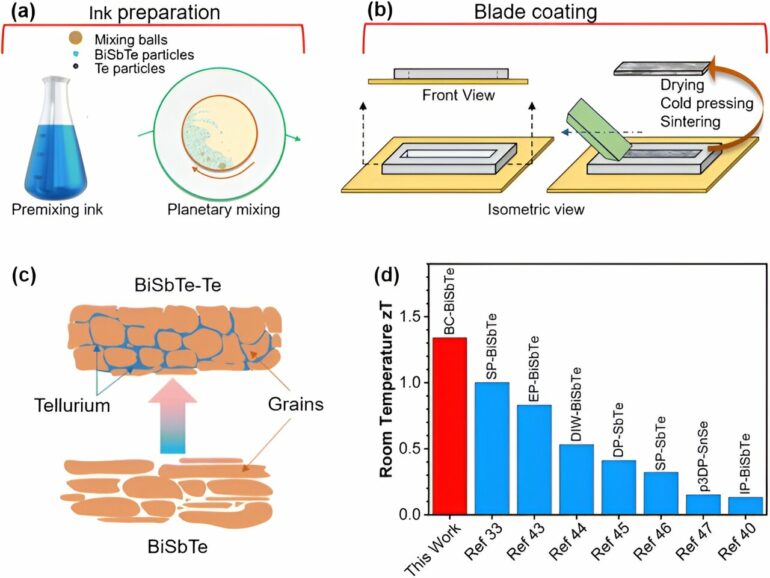Power plants, factories, car engines—everything that consumes energy produces heat, much of which is wasted. Thermoelectric devices could capture this wasted heat and convert it into electricity, but their production has been prohibitively costly and complex.
Yanliang Zhang, the Advanced Materials and Manufacturing Collegiate Professor of Aerospace and Mechanical Engineering at the University of Notre Dame, and colleagues from a multi-institutional team have devised an ink-based manufacturing method making feasible the large-scale and cost-effective manufacturing of highly efficient thermoelectric devices.
Their finding were recently published in Energy & Environmental Science.
“Using our novel ink recipe and processing technique, we’ve been able to produce a material that’s more efficient in converting waste heat into power than any previous ink-produced device,” Zhang said. “With this method, we can make devices in a broad range of sizes—a film a few microns thick or a device big enough to collect waste heat from a power plant.”
To convert heat into electric power, thermoelectric devices require a hot side and a cold side. Electric current should flow easily through the material, but heat should not, since that would eliminate the temperature gradient needed for the device to function efficiently.
Materials with these unique properties were previously produced, Zhang said, by labor- and energy-intensive processes that lacked uniformity and scalability.
The team’s ink “recipe” mixes thermoelectric particles with a solvent plus tellurium, an additive that reduces defects in the material and helps compact and solidify the resulting composite. The team’s ink-based production technique also gave them more control over the material’s microstructure and final 3D geometry compared with previous methods.
Thermoelectric devices can also be used for emission- and refrigerant-free cooling, if electric power is provided.
“We believe our findings hold great promise for waste heat recovery, energy efficiency improvements, CO2 emission reduction, and environmentally friendly solid-state cooling and refrigeration,” Zhang said.
More information:
Ali Newaz Mohammad Tanvir et al, High-performance thermoelectric composites via scalable and low-cost ink processing, Energy & Environmental Science (2024). DOI: 10.1039/D4EE00866A
Provided by
University of Notre Dame
Citation:
New ink-based method offers best recipe yet for thermoelectric devices (2024, July 2)



